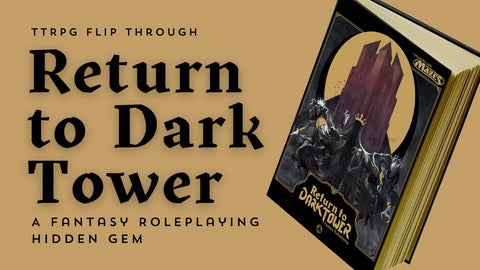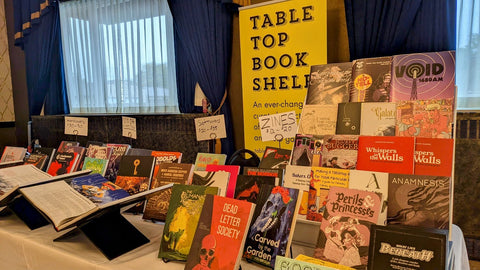The Pricing Game
The question of how to price your tabletop RPG depends on many factors, and of course, no one is stopping you from pricing your 10-page zine at $100. But I’m guessing the market for a $100 zine is pretty small. Perhaps the better question is, “What price should I set for my book or zine to match audience expectations?”
Your friendly online bookseller is here to help! In this post, I’ll break down the standard price-range categories for tabletop RPG books and zines and offer some examples within the shop from each price range, where I can. There's a bit of play within each range, but the lines are pretty clear if you take a step back.
$5-$10 - Brochures and Short Zines
At this price level, customers are okay with brochures or brochure sets and short zines, usually around 10 pages or less. Customers at this price point are looking for add-ons or one-shots to games they already have or quick start rules. Even at this price point, however, customers will appreciate a level of polish or intention, such as heavier cardstock.
Be aware that at this price point, it rarely makes sense to sell these online as the cost to ship will be equal to or higher than any profit gained. These will perform best at in-person events like conventions or brick-and-mortar locations, particularly where they can be positioned as an add-on or quick purchase.
$10-$20 - The Zine Sweet Spot
Most TTRPG zines and solo games will fall into this price range, with a lot of leeway based on the game and level of polish. A longer zine with a higher quality cover and pages can even go over $20. Customers are expecting at least one solid gameplay session out of games at this level, and creators should be sure their creations are playtested beyond their friend group.
Some perfect-bound books or booklets will also fall into this category. Oftentimes the paper quality may be lower to make up for the increased binding cost. There’s a perception that perfect-bound books are higher quality than staple-bound, and they certainly cost more. But perfect-bound books and booklets don’t rest open flat and can be frustrating to use in play, especially if they have lower page counts.
Examples:
Whispers in the Walls
Carved by the Garden
$20-$30 - Perfect Bound Softcovers
This is a the range for most perfect-bound or softcover TTRPG books that are too large to be classified as a zine. For perfect-bound books, there are more options to play with in terms of paper quality and cover quality, and these all contribute to value-perception. Perfect-bound books also allow for more pages, which means more illustrations, a big driver of value perception.
The biggest issue for retailers with perfect-bound, softcover books is that they are more susceptible to wear and tear. While they are cheaper to ship, it’s easy for a corner to get smooshed or a cover to get bent or torn. This can be mitigated by having your printer shrink-wrap your books. Not only does it help with protection, but customers also love knowing they are the first person to touch a book.
Examples:
Perils & Princesses
Fabula Ultima Core Rulebook
$35-$45 - Small Hardcovers
Unless it’s a truly special or huge softcover, customers spending over $30 expect a hardcover. Many examples of titles at the $40 price point have a certain level of polish, such as bookmark ribbons or foil stamping. Color is not a necessity! If you plan around black-and-white pages and get illustrations to match, you can save a lot in cost.
These days, there are options for print-on-demand hardcovers. These are never going to have the level of quality of traditional offset print runs. If you try to sell your print-on-demand title at offset prices, expect dissatisfied customers. On the other side of the equation, the price per book is generally higher for print-on-demand than traditional offset.
My recommendation is don’t go into hardcovers until you have built up an audience to support an offset print run.
Examples:
Mazes
Orbital Blues
$50-$70 - Standard Hardcovers
Thanks in large part to our friendly coastal wizards, customers spending $50 or more expect the highest production level possible. Professional illustrations, design, and editing. Gloss pages. A smaller hardcover may fall into this category if it’s a special edition.
Since most books in this range have the same form factor, the price range is mostly dependent on demand and page count, with 100-200 page books, oftentimes supplements, closer to the $50 range, and meaty core rules or settings books pushing into the $60 or even $70 range.
Examples:
Cyberpunk RED Core
Dungeons of Drakkenheim
$75+ - Special Editions and Oddballs
At this price range, customers are often collectors and are looking at the purchase not just as a book or game but also as a piece of art and maybe even an investment. In most cases, this means limited-run special editions with unique covers and the highest level of polish.
There are also "oddball" game books in this range with unique features, including a few the justify larger prices with huge page counts. I’m skeptical of this approach. If your book is this large, I recommend breaking it up into two or even three smaller books. There are many reasons for this, but one is that it gives your customers more options to access your hard work.
Examples:
Dead Letter Society Special Edition
DIE RPG Slipcase Edition
Under $5 - Is It Worth It?
On the other end of the spectrum, I’m also skeptical of offering physical game products for under $5. Products in this price range are not economically viable for most e-commerce models; the cost of shipping is likely higher than the the cost of the product itself. Single brochure games and very short zines for in-person events can work here, but is this really worth the effort when you could spend a bit more time and produce a game with a much broader reach?
I’d also consider, if you have something small like this, giving it away as a marketing tactic. People love free stuff, and it’s a great way to build an audience, especially if you have a vibe or hook that’s likely to get shared beyond the person you give it to.
Conclusion
My final piece on pricing is to remember the quote, “Price is what you pay. Value is what you get.” A conversation about the price of a game book is not a conversation about the value of the art within or the artist behind it. Instead, it’s a conversation about the current marketplace and the expectations that have been set by big publishers and big retailers in their efforts to maximize shareholder value.
I didn’t make the rules of the price game, but I will say this: When you take the “big” out of the picture, the artist benefits.
- Tom G ✌️🤓




